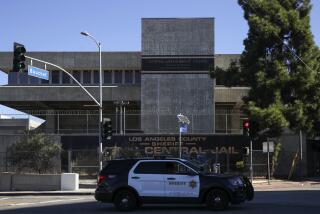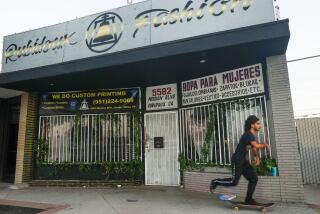Beatings reveal vulnerability of O.C. jails’ child-sex suspects
Orange County jails are the only ones among the state’s five largest jail systems that do not automatically provide protective custody to inmates accused of sex crimes involving children, leaving them vulnerable to attacks like the one last month in which a prisoner was beaten to death.
A second inmate, awaiting trial on charges of child molestation, was severely beaten in June and has just recently been released -- brain-damaged, according to his family -- after five months in a hospital.
The Sheriff’s Department’s decision to pull back protection for child molestation and child pornography possession suspects -- perhaps those most despised by other prisoners -- occurred sometime in the last three years, according to two law enforcement sources with knowledge of the situation.
The two recent incidents have brought attention to the change of policy. Because of the change, inmates at Theo Lacy Jail in Orange were able to fatally beat John Chamberlain, accused of possessing child pornography, on Oct. 5. At the Central Men’s Jail in Santa Ana, another group of inmates severely pummeled suspected child molester Fernando Ramirez in June.
“I’m not surprised,” said San Francisco Sheriff Michael Hennessey, whose jails segregate those accused of sex crimes involving children. “They are vulnerable, so we treat them as potential targets. “I can imagine how a different policy would create problems.”
The Orange County policy calls for such inmates to be placed in protective custody if jailers learn the prisoner is in danger, according to sheriff’s spokesman Ryan Burris.
Top officials in the Sheriff’s Department refused to comment on whether a policy change had occurred or to provide other details about it. The sources spoke on condition of anonymity because they were not authorized to speak.
Attacks in jails on suspected child molesters have been a problem elsewhere. The Los Angeles County Sheriff’s Department in 1998 investigated allegations that deputies encouraged inmates to beat 13 accused sex offenders while in custody.
The families of Chamberlain and Ramirez say their cases show that Orange County sheriff’s officials may have missed warnings that their relatives were in danger.
Hours before Chamberlain was killed, his public defender, Case Barnett, called jail officials to warn them that his client felt his life was in danger and to urge them to place him in protective custody. He was not moved.
Chamberlain’s family has filed a claim against the county saying the Sheriff’s Department was negligent by not responding to Barnett. Inmates had reportedly been asking Chamberlain about the charges against him and became hostile when he evaded the question.
In the aftermath of Chamberlain’s death, the public defender’s office asked for better responses in the future, and the sheriff’s office agreed to provide a 24-hour contact number for attorneys to call, according to Jane Wilkinson, a senior assistant public defender.
The department is investigating the death at Sheriff Michael S. Carona’s insistence, despite a department policy approved in 1985 “to immediately refer to the Orange County District Attorney’s Office all cases wherein ... the deceased or seriously injured was in the custody of this department.” The Sheriff’s Department would allow the district attorney’s office only to monitor the investigation’s progress.
The Sheriff’s Department also investigated Ramirez’s beating.
Ramirez’s family, which has also filed a claim, said the Sheriff’s Department should have seen the warning signs in their case as well. His sister, Narbey Ramirez, said Fernando had called their brother to say a jail guard had sent someone to beat him several days before the attack that sent him to the hospital and that he was in pain.
A few days later, on June 1 at 7:30 p.m., inmate Lonnie Millaponce allegedly rounded up six other inmates to beat Ramirez. Four of the men wrapped their hands with torn sheets and socks and cornered Ramirez, punching and kicking his torso and head, according to prosecutors. One inmate, Douglas Hitchcock, allegedly cleaned up the blood and flushed a bloody towel down a toilet before guards finally responded to the attack, according to prosecutors.
Millaponce, Hitchcock and four other inmates are charged with aggravated assault.
The attack occurred in the oldest section of the Central Men’s Jail complex, a high-security concrete facility built in 1968. The cells are almost completely out of sight from the guard station at the end of the long corridor and are not monitored by video cameras. Many inmates are able to roam from one end to the other. The loud echo of chattering prisoners makes it difficult to hear specific sounds.
Sheriff’s spokesman Burris said Ramirez probably would have received protection had he told guards that he felt unsafe or if he had gang affiliations or medical reasons to necessitate protective custody. The state prison system follows a similar policy.
Ramirez’s family was not told of the attack, a violation of a Sheriff’s Department policy that requires notification of life-threatening injuries. Department spokesman Jim Amormino said jail supervisors might not have realized the extent of Ramirez’s injuries.
The family learned that Ramirez was hospitalized when they made inquiries after attending two court dates in which he failed to appear. On June 9, the Sheriff’s Department told them he was being held in a hospital jail ward, Narbey Ramirez said.
The family made repeated trips to the hospital but were turned away by deputies until they obtained a court order on June 23 and were allowed to visit Ramirez for 15 minutes, Narbey Ramirez said.
Amormino said a jail supervisor had approved family visitation rights from the start of Ramirez’s hospitalization and that he did not know why deputies didn’t carry that order out.
Narbey Ramirez said her brother was in bad shape. “It was like he was a corpse,” she said.
The whites of his eyes had turned purple, and he was bruised from head to toe. He had a broken arm. The doctors said he had suffered damage to his brain stem, she said.
When a reporter met him Nov. 1, the day he was released from the hospital and jail custody, Ramirez appeared disoriented but was able to engage in light conversation. He could not remember that he had been released from the hospital a few hours earlier.
Ramirez is still awaiting trial on the charge that he molested a young girl in a playground while he was picking up his nephew from school. Ramirez’s attorney, Anthony Sessa, denies that any touching occurred.
*
More to Read
Sign up for Essential California
The most important California stories and recommendations in your inbox every morning.
You may occasionally receive promotional content from the Los Angeles Times.











